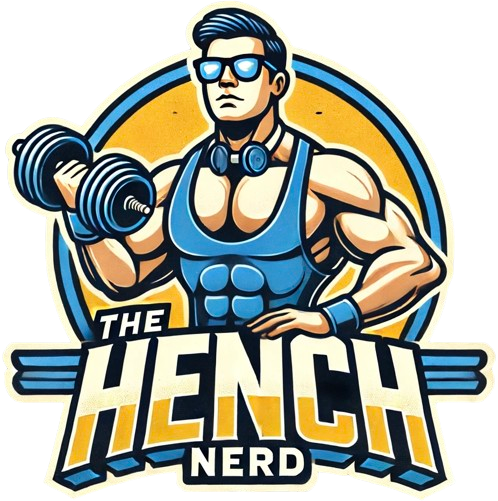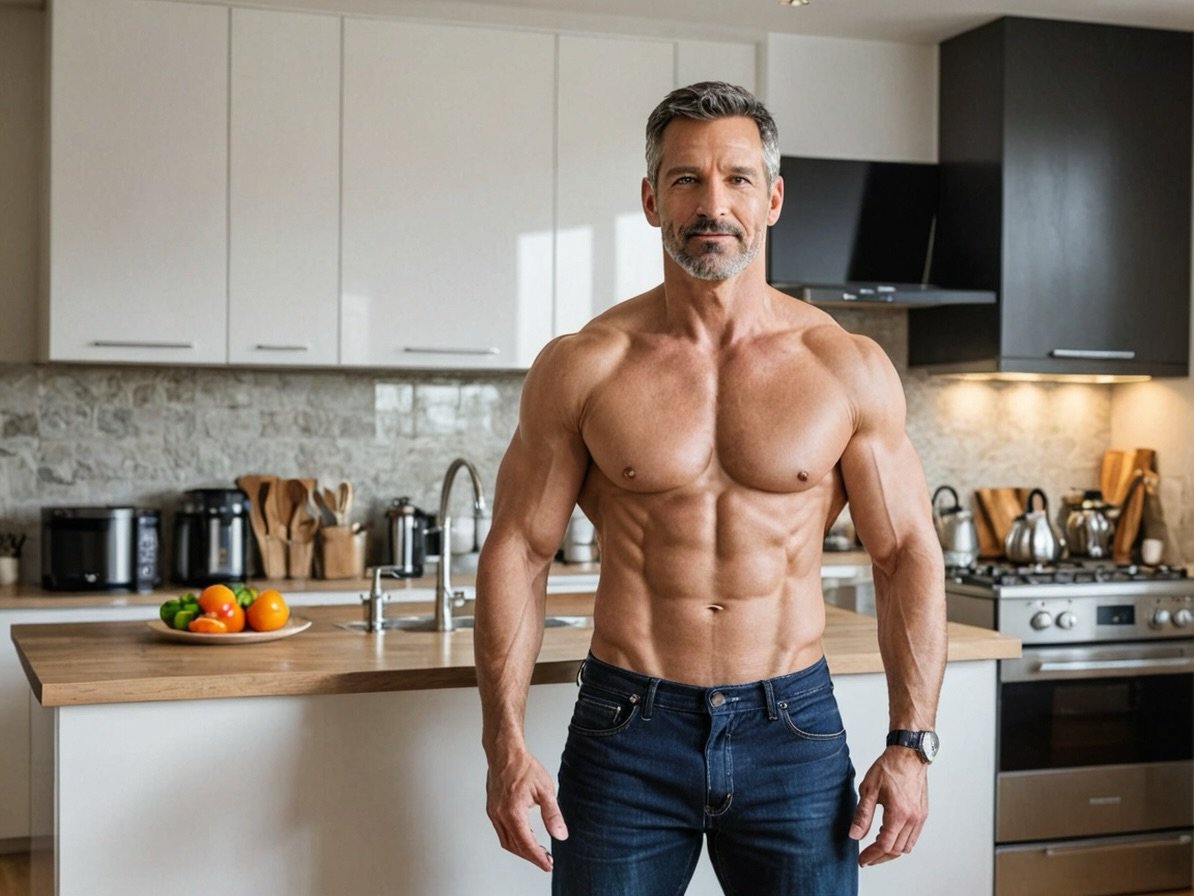Welcome to the ultimate guide for building strong and defined abs at home. For men over 40, achieving visible abs can be a tough challenge, but it’s certainly not impossible. In this article, we’ll explore the most effective Great Ab Exercises at Home and highlight why focusing on simplicity, intensity, and diet is crucial for unveiling those sought-after abdominal muscles.
I remember back in my teenage years, I would dedicate 50 minutes alone to my abs and train them at least three times a week. At the time, I thought endless sets of crunches and leg raises were the key to getting those coveted six-pack abs. But it wasn’t until my late 20s that I realised the most significant factor in seeing visible abs wasn’t the volume of my training but my body fat percentage (more on this later).
In fact, it was only when I got to around 15% body fat that my abs started to become visible, even though my workouts in the gym or at home only took about 10 minutes tops.
Great Ab Exercises At Home key Takeaways
- Visible Abs Require Low Body Fat: You need a body fat percentage of 8-12% for a six-pack and 12-16% for visible definition. Focus on maintaining a caloric deficit to reduce overall body fat. Getting ripped at home is all about diet.
- Intensity and Progressive Overload: Treat your abs like any other muscle. Use high intensity and progressively increase difficulty over time.
- Focus on Two Key Exercises: Incorporate Leg Raises for the lower abs and Crunches for the upper abs. These simple exercises target different regions of the abdominal muscles effectively.
- Engage the Entire Core: Leg raises and crunches activate not just the rectus abdominis but also the obliques and transverse abdominis.
- Avoid Common Mistakes: Don’t use momentum, control each movement, and avoid overtraining. Train abs 2-3 times a week, allowing for adequate recovery.
The Science Behind Ab Muscle Growth
The abs, or rectus abdominis, are responsible for spinal flexion and stabilising the core. They’re involved in a wide range of movements and are engaged in many weightlifting exercises where they act as stabilisers. This indirect activation means that even without doing specific ab exercises, your core is already getting a fair amount of work.
Research has shown that the best way to build and strengthen your abs is to treat them like any other muscle group—focus on intensity, progressive overload, and giving them time to recover. The rectus abdominis, along with the obliques and transverse abdominis, are recruited to stabilise and move the torso. But because they’re often engaged during other compound movements, you don’t need to spend a lot of time training them directly.
Abs are like any other muscle—you need to train them with intensity, progressive overload, and proper form. But remember, even the strongest abs will remain hidden unless your body fat is low enough to reveal them.”
— Dr. Eric Helms, PhD, Exercise Science, author, and coach.
Muscle Growth: What Really Drives It?
Building muscle, whether it’s your abs or any other muscle group, is governed by the principles of intensity, progressive overload, and volume. Understanding these concepts is essential for maximising your results.
Intensity vs. Volume: What’s More Important?
Muscle growth, or hypertrophy, happens when resistance training causes microtears in muscle fibres, which the body repairs, resulting in stronger and thicker muscles. Two key factors drive this process: intensity (the effort exerted during each set) and volume (the total amount of work calculated as sets x reps x weight).
- Intensity: Refers to the level of effort exerted during a set. High-intensity training, where you perform each set close to muscle failure, activates more muscle fibres and results in greater muscle growth.
- Volume: Total amount of work performed in a workout, calculated as sets x reps x weight. For hypertrophy, moderate volume with a focus on time under tension tends to work best.
Research published in Sports Medicine revealed that the rectus abdominis is most activated during exercises that involve spinal flexion, such as crunches and leg raises, due to the recruitment of the upper and lower portions of the muscle.”
— Sports Medicine.
The Science Behind great Ab Exercises At Home

The abdominal muscles, commonly referred to as “abs,” are composed of several different muscle groups that work together to stabilise the core, support the spine, and enable a wide range of movements. The primary muscles making up the abs include:
- Rectus Abdominis: This is the “six-pack” muscle that runs vertically along the front of your abdomen. It’s responsible for spinal flexion, or bending the torso forward. The rectus abdominis can be divided into the upper and lower regions, with exercises like crunches targeting the upper portion and leg raises focusing on the lower portion. Engaging this muscle through a full range of motion is crucial for developing well-defined abs.
- Obliques: These muscles are located on the sides of the abdomen and are responsible for rotation and lateral flexion of the spine. They can be further divided into internal and external obliques, which are activated through twisting and side-bending movements. Although not directly targeted by crunches or leg raises, the obliques assist in stabilising the torso during these exercises.
- Transverse Abdominis: Often referred to as the “corset muscle,” the transverse abdominis lies deep within the abdomen and acts as a stabiliser for the core. It plays a vital role in maintaining posture and preventing lower back injuries. This muscle is engaged during exercises that require bracing and stabilisation, such as leg raises.
Research published in the Journal of Applied Physiology found that eccentric-focused movements, such as the lowering phase during leg raises, result in significantly greater muscle hypertrophy due to increased time under tension.”
— Journal of Applied Physiology.“A study in the Journal of Sports Science and Medicine showed that leg raises and crunches can enhance core stability by activating the transverse abdominis, which is crucial for supporting the spine and preventing lower back injuries.”
— Journal of Sports Science and Medicine.
What The Research Advises About Great Ab Workouts
Studies have consistently shown that exercises like leg raises and crunches activate the rectus abdominis more effectively than other movements because of the increased range of motion and the significant contraction involved. Specifically, leg raises primarily target the lower portion of the abs, which is often difficult to isolate through other movements. In contrast, crunches engage the upper portion by shortening the muscle fibres in the rectus abdominis. Therefore, both exercises are excellent choices for a home ab workout since they require minimal equipment—just a bench and your own body weight.
Additionally, research indicates that engaging the abs through both the concentric (lifting) and eccentric (lowering) phases of these exercises maximises muscle tension and leads to greater muscle activation and hypertrophy. For instance, the eccentric phase of the leg raise, where you lower your legs back down, places the rectus abdominis under significant tension. Consequently, this tension is essential for promoting muscle growth.
By incorporating a balanced mix of exercises that target all regions of the abs, such as leg raises for the lower abs and crunches for the upper abs, you can ensure complete development of the abdominal muscles. Moreover, training the abs with proper form and intensity is vital for achieving muscle definition. However, it’s only part of the equation.
A study published in the Journal of Applied Biomechanics found that the rectus abdominis responds best to exercises that involve both concentric and eccentric loading, such as leg raises and crunches, due to increased time under tension and muscle fibre recruitment.”
— Journal of Applied Biomechanics.
Abs Are Made In The kitchen
When it comes to achieving a defined six-pack, training alone isn’t enough. The old saying, “abs are made in the kitchen,” rings true for a reason. You can train your abs with the best exercises and build strong, muscular core muscles, but unless you have a low enough body fat percentage, those abs will remain hidden beneath a layer of fat. great ab exercises at home, such as crunches and leg raises, won’t make your abs visible if body fat hides them.
To reveal your abs, you need to focus on reducing your overall body fat through diet and working your muscles with exercise. A calorie deficit with high protein will get you mostly there and carbs/fat split as you like (I generally advocate an evenly split approach for active people). Remember, fat loss is a full-body process, and you can’t spot-reduce fat from just your midsection.
For us men, a body fat percentage of around 8-12% is typically needed to see a clearly defined six-pack, with the individual abs visible and separated. If you want a leaner look with good ab definition but don’t necessarily need a shredded appearance, you can aim for a body fat range of 12-16%. Within this range, you’ll see a noticeable outline of your abs and a flatter midsection. Check out my article on curing the skinny fat condition for a great starting guide.
Direct ab exercises like crunches and leg raises are excellent for building core strength and stability, but remember that you can’t out-train a poor diet. Body fat percentage is key to revealing a six-pack.”
— Dr. Brad Schoenfeld, PhD, Exercise Science and author of Science and Development of Muscle Hypertrophy.
Great Ab Exercises at Home
For a well-rounded Great Ab Workout at Home, focus on these two fundamental exercises:
Leg Raises: An Excellent Lower Ab Exercise
Leg Raises are one of the best exercises for targeting the lower portion of the rectus abdominis. These can be performed on a bench or on the ground and help create a strong and balanced core.
- Targets the Lower Abs: Works the lower rectus abdominis, helping to build definition in the lower part of the abs.
- Builds Core Stability: The movement engages the transverse abdominis, which helps stabilise the core.
- Improves Flexibility: Hip flexor involvement helps increase flexibility and mobility in the lower body.
“According to the European Journal of Applied Physiology, performing leg raises with a slight bend in the knees can increase muscle activation in the lower abs without putting excessive strain on the lower back.”
— European Journal of Applied Physiology.
How to Perform Leg Raises:
1. Lie flat on a bench with your legs extended and your lower back pressed against the bench.
2. Place your hands under your hips for support.
3. Raise your legs slowly until they’re perpendicular to your torso.
4. Lower your legs back down without letting your feet touch the ground to complete one rep.
A study published in the Journal of Strength and Conditioning Research showed that performing leg raises on a bench resulted in significantly greater lower rectus abdominis activation compared to standard floor leg raises, due to the increased range of motion and enhanced stabilisation required.”
— Journal of Strength and Conditioning Research.Leg raises are particularly effective for engaging the lower abs, which are often harder to target through traditional ab exercises. When performed with control, they also activate the deep core muscles, enhancing overall core stability.”
— Dr. Mike Israetel, PhD, Sports Physiology and co-founder of Renaissance Periodization.
Crunches: A Classic Upper Ab Exercise
Crunches often get a bad rap, but when performed correctly, they’re still one of the best exercises for developing the upper abs. The key is to focus on the contraction at the top of the movement.
- Targets the Upper Abs: Works the upper portion of the rectus abdominis, helping to build strength and definition.
- Simple and Effective: Requires no equipment and can be performed anywhere.
- Engages the Core and Obliques: The movement also activates the obliques, making it a comprehensive ab exercise.
How to Perform Crunches:
1. Lie flat on your back with your knees bent and your feet flat on the floor.
2. Place your hands behind your head, but avoid pulling on your neck.
3. Lift your shoulders off the ground, engaging your abs as you crunch up.
4. Lower your shoulders back down to complete one rep.
According to research in the American Journal of Sports Medicine, crunches activate both the rectus abdominis and obliques effectively, making them one of the most efficient exercises for core development when performed with proper form.”
— American Journal of Sports Medicine.
You can check out this full body dumbbell workout to view where and how these exercises fit into your schedule (frequency, reps, sets etc).
Common Mistakes to Avoid in Your Ab Workout
Using Momentum
Avoid using momentum to complete your reps. Focus on slow, controlled movements to engage the abs fully.
Neglecting the Eccentric Phase
The eccentric phase (lowering portion) of each exercise is crucial for muscle growth. Lower your legs or shoulders slowly, maintaining tension in your abs.
Overtraining
Abs don’t need to be trained every day. Like any other muscle group, they require time to rest and recover. Aim to train abs two to three times a week for optimal results.
FAQs for Great Ab Exercises at Home
1. How often should I train my abs?
Train your abs 2-3 times per week to allow for proper recovery and muscle growth. Overtraining can hinder progress.
2. Can I build abs with just bodyweight exercises?
Yes, exercises like leg raises and crunches are effective. As you progress, you can increase intensity by adding resistance or slowing your tempo.
3. What body fat percentage do I need to see abs?
For visible abs, men typically need 8-12% body fat for a six-pack or 12-16% for a lean, defined look. Lowering overall body fat is essential.
4. Do ab exercises help burn belly fat?
No, spot reduction is a myth. Ab exercises strengthen your core, but reducing belly fat requires a calorie deficit through diet and overall fat loss.
5. What’s the best exercise for targeting lower abs?
Leg raises are the most effective for isolating the lower portion of the rectus abdominis while also engaging your core stabilisers.
6. How long does it take to see results?
The timeline depends on your starting body fat percentage, diet, and consistency. For most men, achieving 12% body fat or lower can take a few months of disciplined effort.
Conclusion
When it comes to creating the best Great Ab Exercises at Home routine, simplicity is key. Focus on these two foundational movements—Leg Raises and Crunches—to develop strong and defined abs. Combine your training with a clean diet and consistent effort and above all…. don’t repeat my mistake of countless pointless ab workouts.
Chat soon,
Matt

